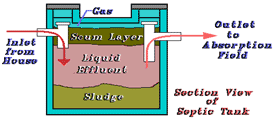Inspecting a Septic System
6/26/2013 A full evaluation of a septic system is recommended to ensure that the system is working properly and that there are no defects that would otherwise go unnoticed in a "visual" evaluation. Either a septic contractor conducts a full inspection of the septic system or, when required, a state certified inspector. This is a multi-step inspection that includes the following:
A full evaluation of a septic system is recommended to ensure that the system is working properly and that there are no defects that would otherwise go unnoticed in a "visual" evaluation. Either a septic contractor conducts a full inspection of the septic system or, when required, a state certified inspector. This is a multi-step inspection that includes the following:
Locating the System
Even professionals may have a problem locating a system if the access to the tank is buried. In such cases the inspector may start by looking in the basement and determining where the sewer pipe exits the home through the wall. Once the inspector has an approximate location he will probe the soil with a thin metal rod in an area ten to fifteen feet from the foundation. In some cases an electronic probe may be used when necessary to determine the location of the tank.
Uncovering the manhole and inspection ports
After the tank has been located, some digging may take place to gain access to the tank. Often times this digging is done by hand and will result in a hole of approximately three feet by three feet. On occasion the depth of the tank and or soil conditions may require a backhoe be used to access the manhole cover.
Evaluating the tank
Once the tank has been accessed the inspector will measure the liquid levels in the tank before pumping the system. Levels are usually tested by inserting a long wooden pole, which is pushed through the different levels of the tank. When the pole is removed the inspector can then determine the levels of sludge and scum in the tank. The inspector will then pump out the system.
The inspector will check the condition of the baffles and tees and also check the walls of the tank for cracks or any signs of failure. He may choose to run water through the system or flush toilets to check the tank for proper flow and ensure there is no back up from the drain field. The size of the tank will also be noted. Septic tanks are usually 1,000 gallons or more, but older tanks may be slightly smaller i.e. 600 gallons. The inspector will determine if the tank is adequately sized for the home that it is servicing. Upon completion of the inspection, the soil and basic landscaping (sod) will be returned but the site will be left mounded. It is important that the site be left mounded to allow for natural settlement of the soil over time. Leveling the soil would allow for additional settling, creating a low spot which can then hold water and cause premature failure of the tank.
The drain field
The inspector will also walk the drain field and look for signs of failure. Lush vegetation, soft spongy ground, a sewage odor, or effluence at the surface are indications that the system is failing. Occasionally the inspector will probe the field lines in an effort to determine that proper drainage is taking place.
Properly cited, designed, constructed and maintained septic systems can provide an efficient and economical wastewater treatment alternative to public sewer systems. To make sure that these systems are performing their intended function, a full evaluation including opening, pumping and inspecting all of its components is recommended.

